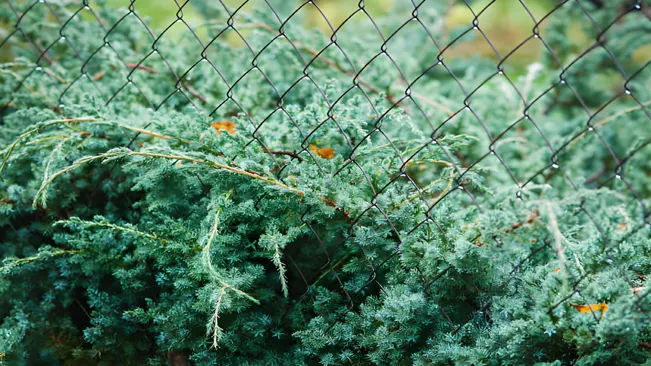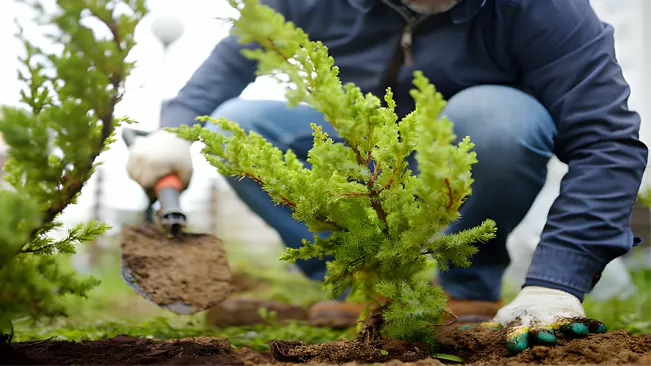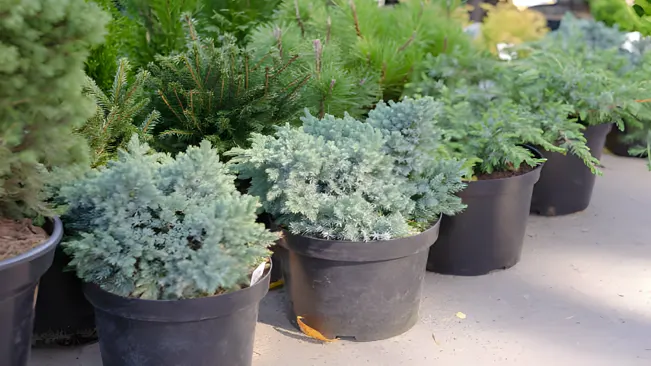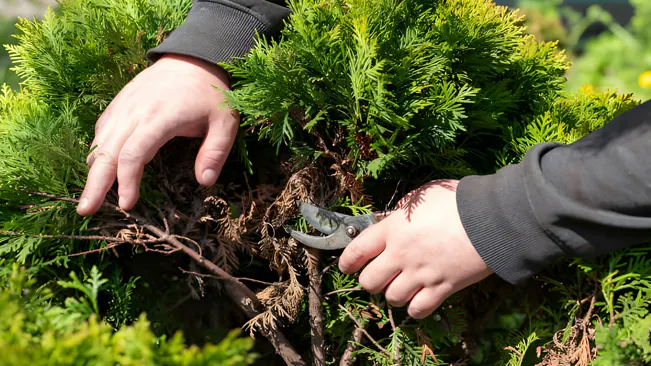How to Grow Blue Star Juniper Shrubs
- March 11, 2024
- 1 comment
Blue Star Juniper (Juniperus squamata ‘Blue Star’) is a popular evergreen shrub known for its striking blue foliage and low-maintenance nature. This compact, slow-growing plant is a favorite among gardeners looking to add year-round color and texture to their landscapes. Here’s a comprehensive guide on how to successfully grow and care for Blue Star Juniper shrubs.

List on How To Grow Blue Star Juniper Shrubs
Selecting a Site
Sunlight
- Importance of Full Sun: Blue Star Junipers require full sun for optimal growth and health. Full sun exposure ensures that the plant can photosynthesize efficiently, which is crucial for its growth and the development of its vibrant blue foliage.
- Daily Sunlight Needs: At least 6 hours of direct sunlight each day is ideal. This amount of sunlight helps maintain the distinctive blue color of the foliage and promotes dense, healthy growth. Less sunlight may result in a less vibrant color and sparser foliage.
Soil Conditions

- Well-Drained Soil: The key to healthy Blue Star Juniper shrubs is well-drained soil. They do not tolerate wet, soggy roots well, which can lead to root rot and other health issues.
- Soil Type Variability: These shrubs are adaptable to various soil types — sandy, loamy, or clay soils can all be suitable as long as they provide good drainage. This adaptability makes them suitable for many different garden settings.
- Soil pH Preference: Blue Star Junipers generally prefer a slightly acidic to neutral soil pH, but they are quite adaptable to different soil pH levels.
Spacing
- Mature Size Consideration: When planting Blue Star Junipers, it’s important to consider their mature size — typically about 2-3 feet in both height and width. Proper spacing is crucial for the overall health of the plant.
- Benefits of Adequate Spacing: Adequate spacing allows for good air circulation around each plant, reducing the risk of fungal diseases. It also ensures that each shrub has enough space to grow to its full size without competing for resources like sunlight, water, and nutrients.
- Spacing Recommendations: As a general rule, space the plants at least 3 feet apart. This distance allows each plant to grow freely without overcrowding, ensuring healthy growth and development.
Planting Your Shrub

Best Time to Plant
- Spring or Early Fall: Planting during these seasons is ideal because the moderate temperatures and natural rainfall patterns help the plant establish its root system. In spring, the growing season is just starting, which allows the plant to acclimate and grow throughout the warmer months. In early fall, the soil is still warm, which promotes root growth, but the cooler air temperatures reduce the stress on the new plant.
Planting Process
- Preparing the Site:
- Soil Testing: It can be beneficial to test your soil’s pH and composition. Blue Star Junipers prefer a slightly acidic to neutral pH. Amendments may be needed if your soil is too alkaline.
- Weed and Debris Removal: Clear the area of weeds and debris to reduce competition for nutrients and water.
- Digging the Hole:
- Size: The hole should be twice as wide as the root ball of your shrub but only as deep. This extra width gives roots room to easily spread out.
- Loosening the Soil: Loosen the soil at the bottom and sides of the hole. This practice helps the roots grow more easily into the surrounding soil.
- Planting the Shrub:
- Removing the Shrub from the Container: Gently remove the shrub from its pot, taking care not to damage the roots.
- Root Inspection: If the roots are densely packed or circling, gently tease them apart to encourage outward growth.
- Positioning: Place the shrub in the center of the hole, ensuring that the top of the root ball is level with or slightly above the surrounding soil level.
- Backfilling:
- Soil: Backfill the hole with the removed soil, tamping down lightly to remove air pockets.
- Watering: Water the shrub thoroughly after planting to settle the soil around the roots and eliminate air pockets.
- Mulching: Apply a 2-3 inch layer of mulch around the base of the plant, keeping it a few inches away from the stem. Mulch helps retain moisture, suppresses weeds, and regulates soil temperature.
- Post-Planting Care:
- Watering: For the first few weeks, water the plant regularly to ensure the soil remains consistently moist but not waterlogged.
- Monitoring: Keep an eye on the shrub for signs of stress or pests and address any issues promptly.
Watering and Nutrients
Watering
- Initial Stage: In the first growing season after planting, regular watering is crucial. This period is when the shrub’s roots are establishing themselves in the soil, requiring consistent moisture. Aim to keep the soil evenly moist but not waterlogged.
- Frequency: During this initial stage, water the shrub once or twice a week, depending on the weather conditions. Hotter, dryer conditions will necessitate more frequent watering.
- Established Plants: Once established, which typically takes about a year, Blue Star Junipers become quite drought tolerant. This means they can survive with much less water.
- Monitoring Moisture: It’s important to check the soil moisture level regularly. The top few inches of soil should be allowed to dry out between waterings. Overwatering can lead to root rot and other issues.
- Seasonal Adjustments: Reduce watering in the cooler months when the plant’s growth slows down and its water needs decrease.
Fertilizing
- Type of Fertilizer: A balanced, slow-release fertilizer is ideal for Blue Star Junipers. Look for a fertilizer labeled for use with evergreen shrubs or specifically for junipers.
- Timing: The best time to fertilize is in early spring, just as the growing season begins. This helps the plant get the necessary nutrients to support new growth.
- Application: Follow the instructions on the fertilizer package for the correct application rate. It’s important not to over-fertilize, as this can lead to excessive growth, making the plant more susceptible to diseases and pests.
- Frequency: Generally, an annual application is sufficient. If the shrub is planted in particularly poor soil, a second application in mid-summer can be beneficial, but this is rarely necessary.
- Signs of Over-Fertilization: Look out for signs like yellowing leaves or wilting, which can indicate over-fertilization. If this occurs, reduce the amount of fertilizer and increase watering slightly to help flush out excess nutrients.
Pruning and Maintenance
Pruning
Why Pruning is Important: Pruning is essential not just for maintaining the shape and appearance of your Blue Star Juniper but also for its overall health. It helps in removing dead or diseased branches, allowing for better air circulation and sunlight penetration which are crucial for the health of the plant.

When to Prune: The ideal time for pruning is late winter or early spring, just before new growth starts. This timing helps the plant heal quickly without stunting the development of new shoots.
How to Prune
- Inspect the Plant: Look for dead, diseased, or damaged branches. These are typically dry, brittle, and may show signs of discoloration.
- Use the Right Tools: Clean, sharp pruning shears or a saw for thicker branches are essential for making clean cuts.
- Pruning Technique: Make cuts at a slight angle, about 1/4 inch above a bud or branch junction. This promotes healthy new growth.
- Shape Maintenance: While Blue Star Junipers naturally have a pleasing shape, you can lightly trim them to maintain their compact, rounded form. Avoid excessive pruning, as it can lead to sparse foliage and reduce the plant’s natural beauty.
Pest and Disease Control
Common Pests
- Spider Mites: These tiny pests can cause foliage to turn yellow and drop. They’re more common in hot, dry conditions.
- Juniper Scale: Scale insects can cause yellowing of needles and reduced plant vigor.
Common Diseases
- Fungal Diseases: Root rot, needle blight, and rust are common fungal issues. These often manifest as discolored needles or patches of dead foliage.
Prevention and Treatment
- Regular Inspection: Regularly check for signs of pests and diseases. Early detection is key to effective treatment.
- Appropriate Treatment: Use insecticides or miticides for pest control. Fungicides can help in managing fungal diseases. Always follow the label instructions for safe and effective use.
- Cultural Practices: Good cultural practices like proper watering, avoiding overhead irrigation, and ensuring good air circulation around the plant can significantly reduce the incidence of pests and diseases.
- Quarantine New Plants: When introducing new plants to your garden, keep them isolated initially to ensure they don’t carry pests or diseases that could spread to your Blue Star Junipers.
Winter Care
Blue Star Junipers are hardy and can withstand cold temperatures, but extreme conditions can still pose a threat. The main challenges during winter include:
- Frost Damage: Frost can burn the foliage, leading to discoloration and weakening of the plant.
- Desiccation: Cold winds can dry out the foliage, particularly when the ground is frozen and roots cannot absorb water.
- Snow and Ice Load: Heavy snow or ice can break branches, especially in younger plants.
Steps for Winter Protection
- Watering Before Freeze: Ensure the soil around the shrub is moist (but not waterlogged) before the ground freezes. This helps prevent desiccation.
- Mulching: Apply a layer of mulch around the base of the shrub. This helps insulate the soil, keeping it warmer and reducing the impact of temperature fluctuations.
- Wrapping with Burlap: Wrap the shrub in burlap to shield it from harsh winds and heavy snow. Here’s how to do it effectively:
- Erect a few stakes around the shrub to create a framework.
- Wrap burlap around the stakes, creating a barrier. Ensure the burlap does not directly touch the foliage, as this can cause moisture buildup and potential fungal issues.
- Secure the burlap with twine or clips.
- Avoiding Salt Damage: If your shrub is near a road or pathway where de-icing salts are used, it’s important to shield it from salt spray, which can be damaging. The burlap wrap can help with this as well.
- Snow and Ice Management: Gently brush off snow from the branches after heavy snowfall. Avoid shaking the branches, as this can cause breakage, especially when they are brittle in cold weather.
Post-Winter Care
- As spring approaches, gradually remove the protective measures. Remove the burlap wrap and stakes carefully to avoid damaging the branches. Check the shrub for any signs of damage or disease and prune as necessary.
Conclusion
Growing Blue Star Juniper is a rewarding experience for any gardener. Their ease of care, beautiful blue foliage, and adaptability make them an excellent choice for both novice and experienced gardeners. By following these guidelines, you can enjoy the vibrant presence of Blue Star Juniper shrubs in your garden for many years.
FAQs (Frequently Asked Questions)
- What is the best time to plant Blue Star Junipers?
Planting in the spring or early fall is ideal, as it allows the shrub to establish its root system before extreme hot or cold weather. - How much sunlight do Blue Star Junipers need?
They require full sun, meaning at least 6 hours of direct sunlight daily. - What type of soil is best for Blue Star Junipers?
They thrive in well-drained soil and can adapt to a range of soil types, from sandy to clay, as long as they have good drainage. - How often should I water a Blue Star Juniper?
Regular watering is crucial during the first growing season. Once established, they are drought-tolerant and need minimal watering. - Do Blue Star Junipers need fertilizer?
A balanced, slow-release fertilizer can be applied in early spring, but avoid over-fertilizing as it can harm the plant. - How big do Blue Star Junipers get?
They typically grow to about 2-3 feet in height and width, making them a compact shrub option. - Is pruning necessary for Blue Star Junipers?
Minimal pruning is required. It’s best to remove only dead or damaged branches in late winter or early spring. - Are Blue Star Junipers resistant to pests and diseases?
While relatively hardy, they can still be affected by common juniper problems like spider mites or fungal diseases, which should be treated promptly. - How do I protect my Blue Star Juniper during winter?
In regions with harsh winters, protect the shrub from extreme cold and wind, possibly by wrapping it in burlap for the first few winters. - Can Blue Star Junipers be planted in containers?
Yes, they can grow well in containers, provided they have sufficient room for root growth and proper drainage.

Kristine Moore
Forestry AuthorI'm Kristine Moore, a seasoned garden landscaping professional with over 30 years of experience. My extensive career has been dedicated to transforming outdoor spaces into stunning, sustainable landscapes. With a deep understanding of horticulture, design principles, and environmental stewardship, I have become a respected figure in the field, known for creating harmonious, visually appealing, and eco-friendly gardens. My commitment to excellence and continuous learning in landscaping trends and techniques has solidified my reputation as an expert in garden design and implementation.













We just planted Blue star shrub and the leaves are turning a little yellow. We are watering twice a day 10 minutes with a. waterline going to them. We live in a desert climate it is about 100° right now for a week. How much should we water more?
Albert Huth
July 19, 2024 3:41 pm